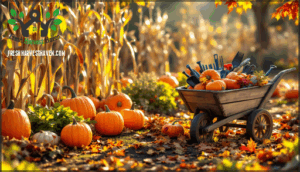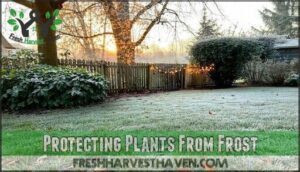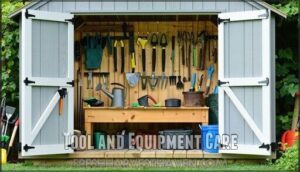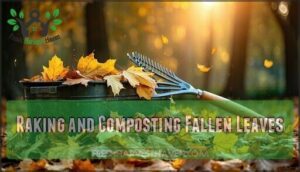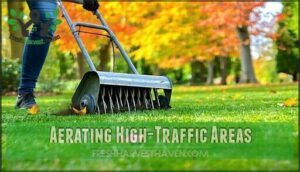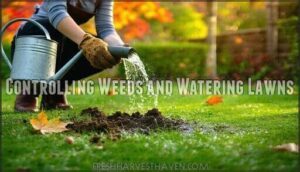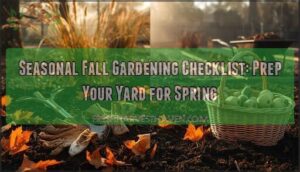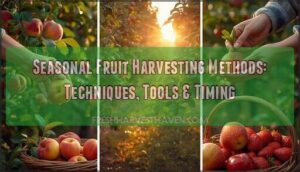This site is supported by our readers. We may earn a commission, at no cost to you, if you purchase through links.
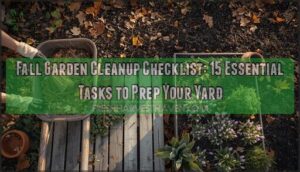
Remove spent annuals and diseased plants immediately to prevent pest overwintering.
Add compost to beds and plant cover crops for soil health.
Bring tender plants indoors while mulching hardy perennials for protection.
Clean and store garden tools properly, drain small engine fuel, and prepare equipment for storage.
Rake leaves for composting, aerate compacted lawn areas, and plant spring bulbs before ground freezes.
This systematic approach protects your investment and prevents spring headaches, all dependent on timing these tasks correctly with your local frost patterns, ensuring a successful fall garden cleanup and maintaining garden tools properly.
Table Of Contents
- Key Takeaways
- Fall Garden Cleanup Timing
- Preparing Soil for Winter
- Protecting Plants From Frost
- Tool and Equipment Care
- Winterizing Lawn and Garden
- Frequently Asked Questions (FAQs)
- When should I start my fall garden cleanup?
- What gardening should be done in the fall?
- How do you clean up vegetable gardens in the fall?
- When should I do my fall cleanup?
- How to do a fall yard cleanup?
- How to clean up a vegetable garden at the end of season?
- What should I do before a fall cleanup?
- What to do during Fall Garden cleanup?
- What is a fall garden checklist?
- How do you clean a fall garden?
- Conclusion
Key Takeaways
- Time your cleanup after the first killing frost – You’ll prevent inviting pests and diseases while ensuring maximum benefit from your cleanup efforts.
- Remove diseased plants immediately and dispose of them in the trash – Don’t compost infected material since pathogens survive winter and return stronger next season.
- Add 2-3 inches of compost to garden beds – This creates a nutrient-rich foundation that works through winter to improve soil structure and support beneficial microorganisms.
- Clean and properly store garden tools before winter – You’ll prevent rust damage and extend tool life by removing debris, sharpening blades, and storing them in dry locations.
Fall Garden Cleanup Timing
Timing your fall garden cleanup correctly sets the stage for a healthy spring garden.
You’ll want to start after the first killing frost when annual plants begin to fade, but leave healthy plants until after frost to avoid inviting pests and diseases into your garden beds.
Removing Spent Plants
Dead plant removal after your first frost gives your garden a fresh start.
Clean up after frost hits—your garden’s fresh start begins with clearing spent plants.
Pull out faded annuals and deadhead spent blooms to prevent pest problems and disease spread. Cut beans and peas at ground level, leaving nitrogen-rich roots intact for soil health.
Essential dead plant removal tasks:
- Remove wilted vegetables, flowers, and herbs immediately
- Add healthy plant debris to your compost pile
- Dispose of diseased material in regular trash
- Clear garden pathways of fallen leaves and debris
This fall garden cleanup prevents overwintering pests and creates space for cover crops that’ll protect your soil through winter.
Disposing of Diseased Plants
Infected plants pose a serious threat to your garden’s future health. Disease Control requires immediate action—never compost diseased material, as pathogens survive winter and return stronger next season.
Diseased plants are garden time bombs—remove them now to prevent next year’s disasters.
Instead, bag small debris for trash disposal or bury larger amounts at least two feet deep. Garden Sanitation is vital: sanitize tools with rubbing alcohol between plants to prevent spreading infections.
Plant Disposal of diseased material breaks the disease cycle, while proper Garden Debris Removal protects healthy plants. This systematic approach to Garden Disease Management guarantees your Fall Garden Cleanup eliminates threats before they overwinter and compromise next year’s growing season.
Planning Cleanup Based on Frost Patterns
Planning your fall garden cleanup around frost timing requires understanding your local climate patterns. Your plant hardiness zone determines when that first killing frost arrives, signaling the start of major cleanup activities.
Here’s your frost protection strategy:
- Monitor local weather forecasts for frost damage warnings
- Schedule cleanup scheduling after the first hard freeze
- Identify microclimates in sheltered yard areas
- Adjust winter preparation tasks based on protected zones
Understanding frost protection methods is vital for maintaining a healthy garden during the winter months.
Seasonal shift varies across your property. While exposed areas freeze first, protected spots near buildings or fences stay warmer longer. This knowledge helps you prioritize which areas need immediate attention for your fall garden cleanup checklist versus those that can wait.
Preparing Soil for Winter
Your soil needs proper preparation to survive winter and thrive come spring. Adding compost, organic matter, and cover crops now sets the foundation for a healthy garden next year.
Adding a Layer of Compost
Now you’re ready to nourish your soil for next spring’s growing season.
Spread a 2-3 inch layer of compost across your garden beds using well-aged organic matter. This application enhances soil structure while supporting beneficial microorganisms that drive nutrient cycling throughout winter months.
| Compost Type | Application Rate | Primary Benefits |
|---|---|---|
| Homemade compost | 2-3 inches | Soil enrichment, carbon sequestration |
| Store-bought organic | 2-3 inches | Consistent nutrients, pathogen-free |
| Composted leaves | 2-3 inches | Improved drainage, slow-release nutrients |
| Well-rotted manure | 2-3 inches | High nitrogen, enhanced soil biology |
Understanding compost soil benefits is essential for creating a thriving ecosystem.
Your composting efforts create a living soil amendment that continues working through winter, transforming your garden into a thriving ecosystem for spring planting.
Mixing Organic Matter Into Top Soil
Smart gardeners understand that topsoil mixing transforms ordinary dirt into nutrient-rich growing medium.
Work organic amendments into your garden’s top 4-6 inches during fall dormancy for ideal soil preparation.
This process enhances soil aeration and kickstarts nutrient cycling through winter months.
Focus on these organic matter additions:
- Shredded autumn leaves for slow-release nutrients
- Finished compost to boost microbial activity
- Aged manure for nitrogen enrichment
- Coffee grounds for pH adjustments
- Chopped cover crops for structure improvement
Use gentle incorporation techniques rather than aggressive tilling to preserve beneficial soil organisms.
Replenishing Soil With Compost
After mixing organic matter into your soil, you’ll want to spread a 2-3 inch layer of compost across your garden beds.
This soil amendment delivers essential nutrient cycling benefits that boost microbe balance in your soil ecosystem.
Understanding soil preparation basics is essential for maintaining a healthy garden.
Composting leaves and other organic matter creates a nutrient-rich foundation for spring growth.
Your compost pile becomes nature’s perfect soil preparation tool, transforming waste into garden gold.
Planting Cover Crops
Cover crops act as nature’s winter bodyguards for your garden soil. These hardy plants establish before frost hits, creating a protective living blanket that works around the clock.
Plant them 2-3 weeks before your first expected frost for ideal establishment and erosion control.
Here’s your crop selection strategy for maximum soil enrichment:
- Winter legumes like crimson clover fix nitrogen naturally
- Annual ryegrass provides excellent biomass and root structure
- Cereal rye tolerates harsh conditions and suppresses weeds
- Radishes break up compacted soil layers effectively
- Mixed cover crop types maximize diverse benefits
Broadcasting seeds works fine, though a seed drill guarantees better coverage. These living fertilizers prevent nutrient leaching while adding organic matter when you till them under come spring.
Protecting Plants From Frost
As temperatures drop, you’ll need to take specific steps to protect your plants from frost damage. This preparation guarantees your garden survives winter and thrives when spring returns.
Bringing Tender Plants Indoors
Tropical temperatures drop fast, so you’ll need swift action for tender plant care. Before bringing plants indoors, inspect thoroughly for pests that could spread throughout your home.
Indoor lighting becomes essential—most overwintering plants require bright conditions but less water during dormancy.
Focus on temperature control and humidity management by positioning plants away from heating vents and drafty windows for successful garden winterization.
Planting Bulbs and Trees
Fall’s crisp air signals prime bulb selection and tree planting season. Now’s your chance to establish future garden stars before winter sets in.
Fall gardening success depends on proper timing and soil preparation.
- Plant spring-blooming bulbs like tulips and daffodils after first frost but before ground freezes
- Choose deciduous trees for fall garden cleanup season—they’ll establish roots during cool, moist conditions
- Dig planting holes twice as wide as root balls to encourage lateral expansion
- Apply 2-4 inch mulch layer around new plantings for temperature regulation
This strategic garden design approach reduces transplant shock while maximizing survival rates for next year’s landscape.
Removing Non-Producing Annuals
Most gardeners know that removing spent annuals is like cleaning house – it’s essential for garden sanitation and preventing problems next season.
Start your annual removal by pulling up all non-producing plants completely, including their root systems. This thorough approach supports effective weed control and eliminates hiding spots for overwintering pests.
Don’t forget to deadhead flowers from perennials before final cleanup.
This fall garden cleanup task prepares your beds for crop rotation planning while giving you a clean foundation for spring planting success.
Mulching Around Perennials
Your perennials need a winter blanket to survive freezing temperatures.
Apply a 2-3 inch layer of mulch around these plants after the first hard frost hits your area. Choose from straw, bark chips, or shredded leaves – each mulch type offers different benefits for winter protection and soil health.
This essential fall garden cleanup task insulates root systems, maintains consistent soil temperature, and enhances garden aesthetics during dormant months.
Understanding your region’s first frost date helps you time this perennial care perfectly for maximum winter protection.
Tool and Equipment Care
Your garden tools work hard all season, so they deserve proper care before winter storage.
Clean equipment now prevents rust and extends tool life, while proper maintenance keeps everything running smoothly when spring arrives.
Cleaning and Storing Garden Tools
Why wait until spring to discover your tools have rusted into uselessness? Proper garden tool maintenance now saves money and frustration later.
Clean tools perform better and last decades longer with basic winter tool prep. Regular use of a Garden Tool Cleaner is essential for maintaining tool quality.
Follow these essential steps for effective tool maintenance:
- Equipment Sanitizing: Remove dirt and debris, then disinfect with rubbing alcohol to prevent disease spread
- Garden Tool Sharpening: File blades on pruners, shovels, and hoes for precise cuts next season
- Hand Tool Care: Sand wooden handles smooth, then apply linseed oil for protection
Store cleaned tools in a dry location after thorough drying. Garden hose storage requires complete drainage to prevent freeze damage. This systematic approach to garden tool storage guarantees your equipment stays sharp and ready for spring planting.
Protecting and Maintaining Garden Supports
After your first killing frost, it’s time to tackle garden support maintenance.
Remove stakes, trellises, and cages from garden beds, then inspect each piece for damage or wear.
Clean wooden supports with a bleach solution to prevent disease spread next season.
Install rodent guards around fruit trees and check fence repair needs.
Store clean supports in a dry location—this simple garden tool maintenance step extends their lifespan substantially.
Draining Gas From Mowers and Trimmers
After your lawn mower and string trimmer complete their final cuts, don’t let stale fuel sabotage next season’s start-up.
Fuel drainage prevents gum buildup that clogs carburetors and fuel lines—a costly headache you’ll avoid with proper engine care.
Run equipment until tanks are nearly empty, then siphon remaining gas storage safely.
This essential winterization tip keeps your equipment maintenance simple and your engine preparation solid for spring’s fall yard cleanup revival.
Preparing Small Engines for Winter
Beyond draining gas from your mowers and trimmers, proper engine preparation guarantees reliable spring startups.
Small engines need thorough winter storage care to prevent costly repairs.
Complete these essential engine maintenance steps:
- Oil changes and filter replacement prevent internal corrosion
- Fuel stabilization protects remaining gas from degrading
- Spark plug inspection and replacement maintains ignition efficiency
Mid-winter engine runs keep components lubricated and operational for seamless lawn winterization success.
Winterizing Lawn and Garden
Your lawn needs special attention as winter approaches to guarantee it emerges healthy and vibrant next spring.
Proper fall lawn care sets the foundation for a lush, resilient turf that can withstand cold temperatures and heavy foot traffic, which is crucial for a vibrant lawn.
Raking and Composting Fallen Leaves
Looking at those towering piles of autumn leaves, resist the urge to bag them as yard waste. Instead, transform them into garden gold through strategic leaf raking and composting.
Shred leaves with your mower before adding to compost piles—this accelerates decomposition by 50%. Mix these carbon-rich materials with nitrogen sources for balanced soil enrichment.
| Leaf Management Method | Decomposition Time |
|---|---|
| Whole leaves | 6-12 months |
| Shredded leaves | 3-6 months |
| Composted leaves | 2-4 months |
| Leaf mold | 12-18 months |
| Fall mulch application | Immediate benefit |
Use finished compost as fall mulch around perennials, creating natural winter protection while enriching soil structure for spring growth.
Seeding or Laying Sod
After tackling those fallen leaves, your lawn may need some backup for the coming winter. Fall’s cool temperatures and morning dew create perfect conditions for grass seeding or sod installation. You’ll get stronger root development than spring planting since there’s less heat stress.
Soil preparation makes or breaks your turf establishment success. Remove debris, add quality topsoil, and guarantee good seed-to-soil contact. Your seed selection should match your climate zone and sun exposure patterns.
Here’s your lawn repair action plan:
- Test soil pH – Most grasses prefer 6.0-7.0 range
- Choose appropriate grass type – Cool-season varieties work best for fall
- Prepare seedbed – Rake soil to quarter-inch depth for ideal germination
- Apply starter fertilizer – Phosphorus helps root development
- Maintain consistent moisture – Light, frequent watering prevents seed washout
Understanding soil preparation techniques is vital for a healthy winter garden.
Complete this fall garden cleanup task before your first heavy frost hits. Your lawn maintenance investment now pays dividends with lush spring growth.
Aerating High-Traffic Areas
High-traffic areas suffer from soil compaction that chokes your grass roots and blocks water absorption.
Lawn aeration relieves this pressure by removing small soil plugs, creating breathing room for healthier turf. Core aerators work better than spike versions, which can worsen compaction.
Focus on pathways, play areas, and pet runs where foot traffic concentrates. Traffic control becomes manageable when you tackle compacted zones during your fall garden cleanup.
Soil aeration improves water infiltration by 25% while boosting drought tolerance. Lawn care experts recommend annual aeration for heavily used spaces.
Regular use of a lawn aerator tool can help maintain healthy soil conditions.
Controlling Weeds and Watering Lawns
After aerating compacted soil, your weed control efforts become more effective.
Pull weeds before they set seed, targeting perennial varieties while soil remains workable.
Water conservation matters now—deep, infrequent watering strengthens root systems and prevents soil erosion.
This turf management approach reduces spring problems.
Consistent lawn care tips during fall garden cleanup create healthier grass that naturally outcompetes weeds.
Lawn aeration and proper watering work together for ideal results.
Frequently Asked Questions (FAQs)
When should I start my fall garden cleanup?
Start your fall garden cleanup after the first killing frost when annual plants begin to fade.
In frost-free regions, begin when annuals start dying naturally, focusing on removing diseased plants immediately.
What gardening should be done in the fall?
While most gardeners think winter means rest, you’ll actually tackle essential tasks that determine next year’s success.
Remove diseased plants, add compost layers, plant garlic and spring bulbs, prune dormant trees, and prepare tools for storage.
How do you clean up vegetable gardens in the fall?
Remove diseased plants immediately after first frost, then clear dead vegetables and debris.
Chop bean and pea plants at ground level, leaving roots intact.
Add compost layer and till soil for spring preparation.
When should I do my fall cleanup?
Studies show 80% of garden diseases overwinter in plant debris, making timing vital for your cleanup success.
You’ll want to start after the first killing frost hits or when your annual plants begin fading naturally.
This approach prevents inviting pests while ensuring maximum plant health benefits.
How to do a fall yard cleanup?
Begin your fall yard cleanup by removing diseased plants and debris after the first killing frost.
Clear dead annuals, weed thoroughly, and add 2-3 inches of compost.
Clean and store tools properly for winter.
How to clean up a vegetable garden at the end of season?
First, wait until after the first killing frost before you tackle cleanup.
Remove all diseased plants immediately and toss them in the trash—don’t compost them.
Cut beans and peas at ground level, leaving those nitrogen-fixing roots intact.
What should I do before a fall cleanup?
Like a telegraph operator checking wires before sending messages, you’ll want to wait for the first killing frost to signal proper timing.
Remove diseased plants immediately to prevent pathogen spread, but leave healthy specimens until frost arrives to avoid attracting pests and diseases to your garden ecosystem.
What to do during Fall Garden cleanup?
Remove diseased plants immediately and dispose in trash, not compost.
Cut healthy annuals at soil level, leaving beneficial roots intact.
Thoroughly weed before seeds develop.
Add 2-3 inches of compost across beds and till into soil for spring nutrition.
What is a fall garden checklist?
Don’t think fall garden cleanup is just seasonal busywork—it’s essential for next year’s success.
You’ll remove diseased plants, add compost, winterize equipment, and plant bulbs.
This systematic approach prevents pests and diseases while enriching soil for spring growth.
How do you clean a fall garden?
Start cleanup after the first killing frost kills annual plants.
Remove diseased vegetation immediately, disposing in trash not compost.
Cut spent crops at ground level, leaving roots intact.
Weed thoroughly, add compost, and till soil for spring preparation to ensure a healthy start, focusing on complete garden renewal.
Conclusion
Last winter, Sarah’s prized rose bushes suffered severe damage because she skipped fall cleanup, leaving diseased leaves that harbored fungal spores through the cold months.
Following your fall garden cleanup checklist systematically prevents these costly mistakes, from removing spent plants to storing tools properly.
Your garden’s spring success depends on winter preparation efforts, and these fifteen essential tasks protect your investment and guarantee healthy plant establishment when growing season returns.
- https://www.provenwinners.com/learn/fall/10-fall-gardening-tasks-make-your-garden-sing-next-spring
- https://www.bhg.com/gardening/yard/garden-care/fall-garden-checklist/
- https://yardandgarden.extension.iastate.edu/how-to/fall-garden-tasks
- https://www.southernliving.com/fall-garden-maintenance-8702979?srsltid=AfmBOorZN6o4jddGg6Qruenj9jurDGRWHlb1F0qkAJZS2NQTvQOw-q2l
- https://www.almanac.com/fall-vegetable-garden-cleanup-11-things-do-now

